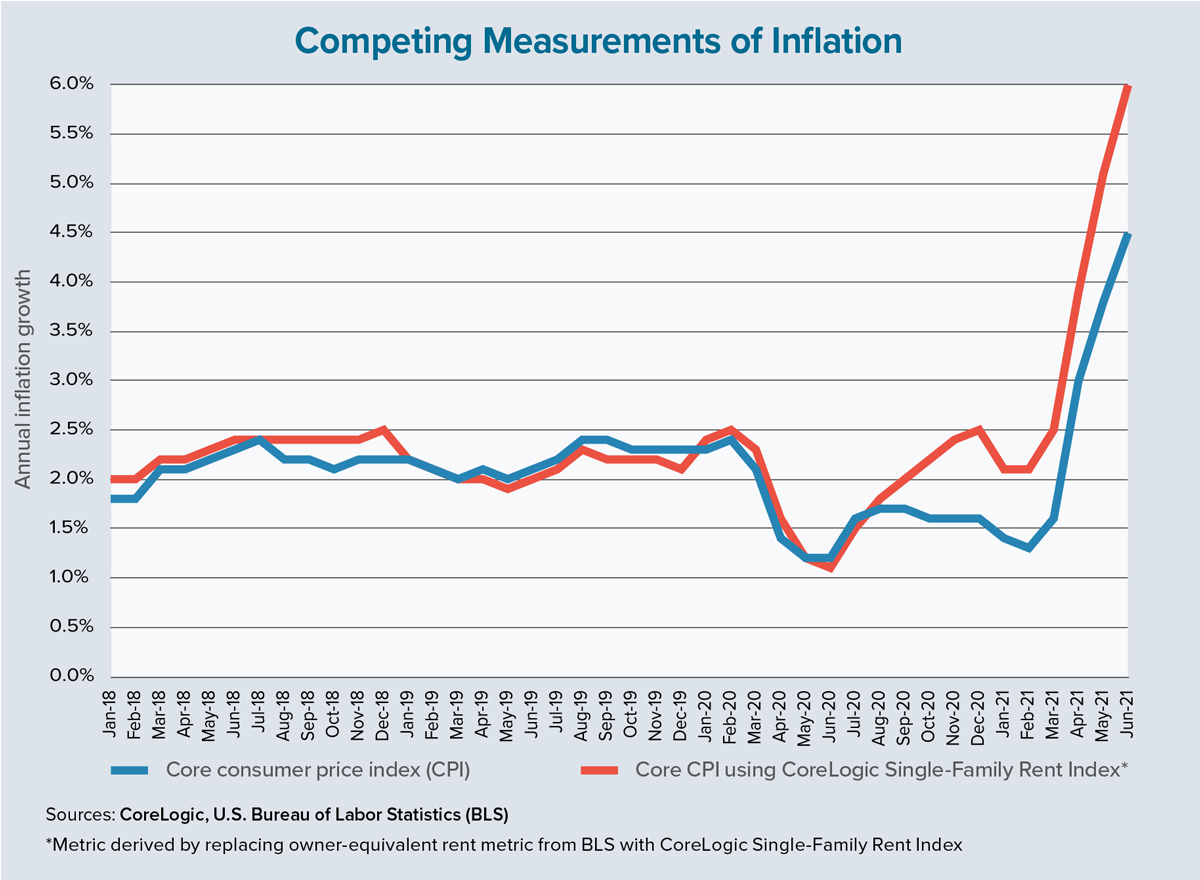Long-term interest rates, such as those for fixed-rate mortgages, are affected by expectations of future inflation. If inflation is predicted to be higher in the future, mortgage lenders will require higher yields to lend funds for an extended period of time. In other words, higher expected inflation means upward pressure on mortgage rates.
The Federal Reserve has been successful in keeping inflation relatively low for the past two decades. From 2000 through 2020, annual inflation as measured by the personal consumption expenditures (PCE) index averaged 1.8% while the consumer price index (CPI) averaged 2%. The PCE, which is compiled by the U.S. Bureau of Economic Analysis, relies on gross domestic product reports to measure the goods and services purchased by all households and nonprofit organizations. Conversely, the CPI is produced by the U.S. Bureau of Labor Statistics through household surveys and only accounts for purchases by households in urban areas.
Wide swings in annualized inflation rates have occurred over the past 20 years. These fluctuations are largely related to up-and-down spikes for food and energy costs. Food and energy prices are often affected by factors beyond the control of monetary policy, such as severe weather or geopolitical events. For these reasons, policy mavens prefer to look at the core price index, which excludes food and energy, tends to be more stable over time and is a less-noisy barometer of underlying inflationary trends.
Shelter is an important component of the core price indexes. For example, rents for primary residences account for 10% of the core CPI. Equivalent rents for homeowners — the estimate of how much a homeowner would pay for rent on their home if they hadn’t purchased it — comprise another 30%. Tenant rents and housing characteristics are used to input an “equivalent” rent for owner-occupied homes. During the COVID-19 pandemic, this method may have led to distorted estimates for owner-occupied housing costs because the majority of tenants live in multiunit properties, whereas nine in 10 homeowners live in one-unit homes.
Since the pandemic began, families have revealed a preference for low-rise structures in less-densely populated neighborhoods, and for single-family homes rather than high-rise apartment buildings. High-rises have seen vacancy rates increase and rent growth decelerate, while the opposite trends have occurred for single-family rental homes.
The CPI’s homeowner-equivalent rent metric has slowed during the past year, slipping from annual growth of 2.8% in June 2020 to 2.3% in June 2021. This is contrary to the acceleration in single-family home prices during this time span. CoreLogic’s Home Price Index saw annualized growth soar from 4.5% to 17.2% while yearly growth for the Single-Family Rent Index jumped from 1.4% to 7.5%.
Replacing the owner-equivalent rent metric with the CoreLogic Single-Family Rent Index (as shown on the accompanying chart) reveals that core CPI inflation would have been about 1.5 percentage points higher this past June than what was reported, or about 6% annual inflation. The last time that core CPI inflation exceeded 6% was 1982.
Inflation forecasts generally indicate that this recent bulge is temporary and inflationary pressures should recede in the coming months. But the owner-equivalent rent index generally lags CoreLogic’s Single-Family Rent Index by nearly 12 months. If this relationship continues in the coming year, then owner-equivalent rent growth will quicken and present a headwind for lower inflation. This implies that inflation tied to the cost of shelter will likely rise in the coming year and place upward pressure on core CPI inflation measurements.
Whether this headwind is sufficient for upward revisions to inflation forecasts, or if it prompts the Federal Reserve to raise interest rates sooner than planned, remains to be seen. Regardless, an acceleration in single-family rent growth will feed concerns about inflation and could add pressure to raise mortgage rates in the coming year. ●
-
Frank E. Nothaft is chief economist for CoreLogic, America’s largest provider of advanced property and ownership information, analytics and data-enabled services. He leads the economics team responsible for analysis, commentary and forecasting trends in global real estate, insurance and mortgage markets. Before joining CoreLogic, Nothaft served as chief economist for Freddie Mac. Prior to Freddie Mac, he was an economist with the Board of Governors of the Federal Reserve System.
View all posts








